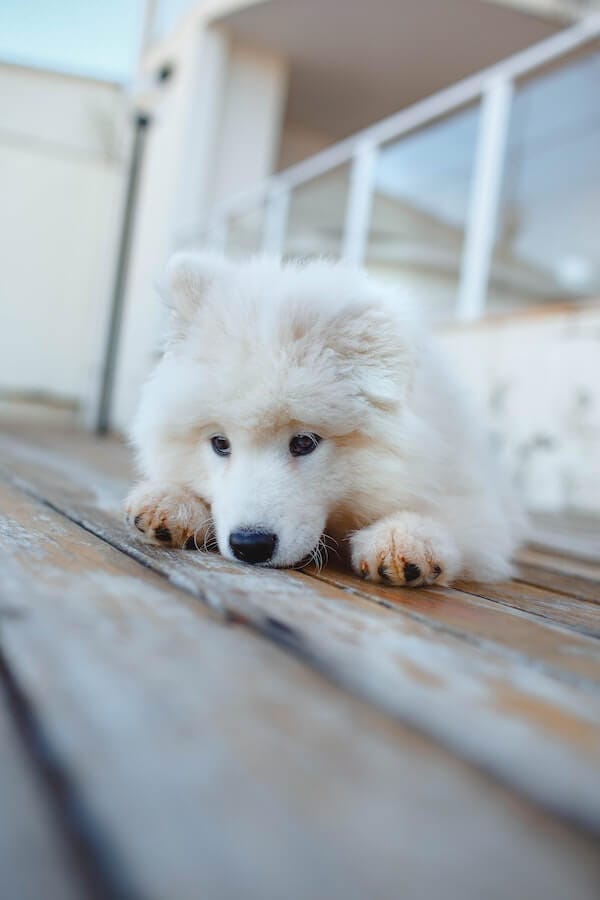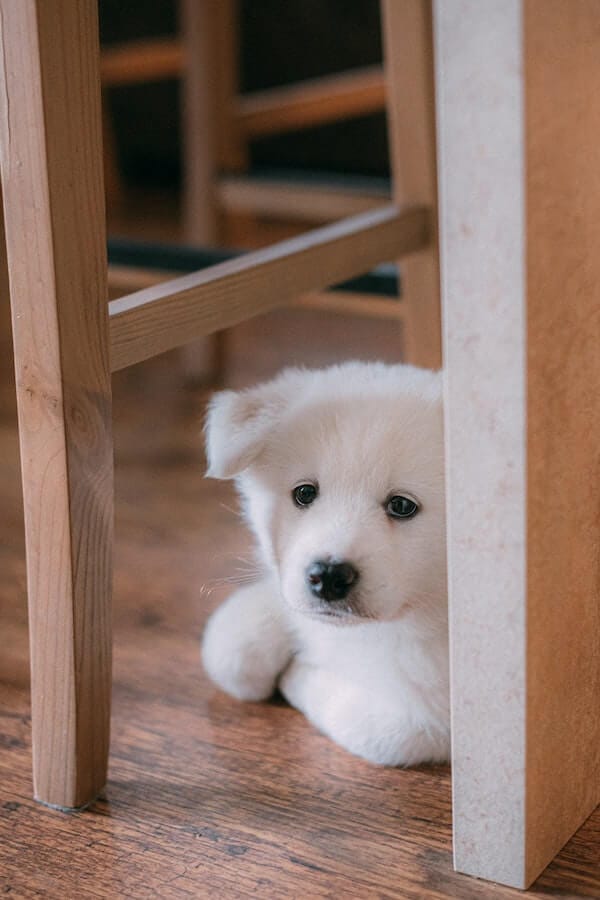
Let’s face it, thunder is a scary sound! So it’s no surprise that dogs are often terrified of thunderstorms. They can become so scared during a storm that they may whimper, hide, or even try to run away. But why are dogs afraid of thunder?
In this article, we’ll explore the possible causes behind their fear and what can be done to help your pup during a storm.
Read on to learn more about how you can comfort your furry friend when there’s thunder brewing.
Why are dogs afraid of thunder?
There are eight potential reasons why dogs may experience fear or anxiety when they hear loud noises:
1. Physiological response:
Loud sounds stimulate the auditory system in a way that induces fear and panic.
A dog’s hearing is much more sensitive than human’s. So even a mild rumble of thunder can sound like an extremely loud noise.
2. Lack of familiarity:
Dogs may not be familiar with the sound of thunder because it’s something that cannot be experienced regularly or consistently in nature.
As such, it can induce fear and anxiety in dogs because it’s something that is outside of their realm of experience.
3. Evolutionary response:
Dogs may have an evolutionary response to loud noises, as a dog’s ancestors faced danger from predators and other threats that could be heard before they were seen.
Loud noises from things such as vacuum cleaners or even firecrackers could indicate the presence of such a threat, so dogs may naturally respond with fear or anxiousness when they hear them.
4. Anxiety towards environmental changes:
Some dogs may become anxious when they sense any type of change in their environment, including changes in weather patterns caused by storm fronts and thunderstorms.
This can cause the dog to associate the sound of thunder with negative emotions or situations, leading to anxiety when the noise is heard again.
5. Fear from past experiences:
If a dog has a negative experience associated with a loud noise in the past, it can cause fear or anxiety when they hear that type of sound again.
This can include events such as being startled by thunder, having a frightening encounter with fireworks, or being exposed to other loud noises that caused discomfort in the past.
6. Lack of exercise/boredom:
Dogs that have not had enough physical activity throughout the day may be more prone to feeling anxious and scared due to lack of stimulation or boredom.
This can cause anxiety when a loud noise is heard, as the dog may not have had enough exercise to expel energy and feel calmer.
7. Sensitivity to barometric pressure changes:
Dogs may be able to detect changes in barometric pressure associated with storms or other weather patterns, which can make them anxious if they are sensitive to such changes.
Indications that your dog is afraid of thunder

It can be hard to tell when your canine companion is scared of the sound, but there are several tell-tale signs you can look out for:
1) Shaking – Does your pet start trembling during a storm? That’s a sign that they’re feeling scared or anxious.
2) Hiding – A pup looking for somewhere safe to hide during a thunderstorm is another surefire sign that they don’t like it.
Whether it’s under the bed or in their favorite bone box, hiding away is an indicator that your dog is trying to keep away from the frightening noise.
3) Panting – Unusually heavy panting, or even drooling, can be a sign of fear from thunder. This is especially true if it’s more vigorous than usual and out of proportion to the heat outside.
4) Barking – Loud barking during storms could indicate severe distress in your pup. Some breeds are more prone to vocalizing their fear than others.
5) Destructive behavior – If your furry friend starts destroying furniture and other items when there’s lightning and thunder outside, they may be trying to distract themselves from the scary sound.
How do you calm a dog down from thunder?

When you hear thunder, the last thing you want to see is your pet’s panic-stricken face. Luckily, there are plenty of ways to help calm a dog during a thunderstorm.
Tip #1
Create an indoor safe space for your pet where they can go when the storm hits.
Make sure it’s stocked with some of their favorite things, like toys or treats, so it’s a place that feels comfortable and secure.
You can also use calming aids like DAP diffusers or Thundershirts to help ease anxiety.
Tip #2
Try distracting your pup with activities they enjoy – this can help take their mind off of the storm.
Treats, and interactive toys are all great ways to keep them occupied and distracted from the sound of thunder.
Tip #3
Stay calm! Your dog will be able to pick up on your own stress levels, so if you’re feeling anxious or overwhelmed, try taking some deep breaths or engaging in a calming activity like yoga or meditation.
Tip #4
Never punish your pet for being scared; this will only make their anxiety worse. Instead, offer them lots of positive reinforcement when they do something that makes you proud!
This could include giving them a treat or extra affection when they remain calm during a storm.
Tip #5
Don’t forget to give your pup plenty of extra love and attention during a storm. Snuggles, cuddles, and belly rubs are all great ways to show them that you’re there for them and will help keep them calm.
Is it normal for dogs to be afraid of thunder?
It’s totally normal for dogs to be afraid of thunder; in fact, it’s probably pretty common. The loud noises and bright flashes can easily spook your pup – even if they don’t fully understand what’s going on.
After all, there’s no way a dog could really make sense of why the sky has suddenly started roaring!
If you notice your dog getting anxious around storms, don’t worry. It’s just their natural instinct kicking in.
Of course, that doesn’t mean they have to suffer through it; there are plenty of things you can do to help them feel more secure.
Depending on the severity of their fear, you may want to consult a vet or trainer who specializes in behavior modification.
Which dog breeds are afraid of thunder?
Many dogs are afraid of thunder, but some breeds tend to be more sensitive than others.
These include Greyhounds, Chihuahuas, Basset Hounds, Shih Tzus, and Poodles – all of which can have a particularly hard time when a storm hits.
If you have one of these anxious dog breeds, it’s best to take extra precautions to help them feel safe and secure during storms.
Conclusion

In conclusion, the answer to why are dogs afraid of thunder is because it is an unfamiliar and loud sound that makes them feel vulnerable.
Dogs also have a heightened sense of hearing which can amplify noise.
So even if your pooch cowers in fear when a storm rolls in, just remember that you’re doing what any good pet owner should do – show them empathy and compassion!
After all, no one likes being scared – not even our furry friends!


GIPHY App Key not set. Please check settings